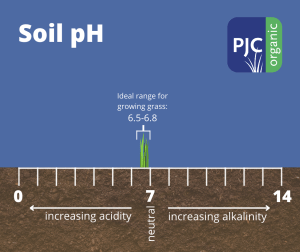It’s nearly fall, so you may be ready to start liming. Although, do you know why we lime? The function of limestone is to reduce the acidity of the soil and change the pH (potential Hydrogen). Liming can provide THREE benefits important to growing healthy turf…
Benefits of Lime
- Improves Soil Chemistry. Soil pH ranges from 0 to 14. Soil pH of 7.0 is considered neutral, below 7 is deemed acidic, and a pH above 7 is considered alkaline. Soils in the Northeast tend to be acidic. As you move west, soils typically increase in alkalinity. Because of how pH is measured, what appears to be a small change can mean a lot:
 A pH of 5.0 is ten times more acidic than pH of 6.0. Accordingly, a pH of 4.0 is a hundred times more acidic than that of pH of 6.0. Turf grass grows best in soil with a pH of 6.5 – 6.8. Soils in this range encourage root growth and make nutrients (fertilizer) available to the grass. Soils with pH 4.0 – 5.0 tend to be seen in forests. As such, they are more conducive to growing white pines and oaks than turf grass. Soil pH also affects nutrient availability. Soils in the 6.0 – 8.0 range tend to have the greatest availability of the macro and micro nutrients that plants need. Below and above this range fewer nutrients are available.
A pH of 5.0 is ten times more acidic than pH of 6.0. Accordingly, a pH of 4.0 is a hundred times more acidic than that of pH of 6.0. Turf grass grows best in soil with a pH of 6.5 – 6.8. Soils in this range encourage root growth and make nutrients (fertilizer) available to the grass. Soils with pH 4.0 – 5.0 tend to be seen in forests. As such, they are more conducive to growing white pines and oaks than turf grass. Soil pH also affects nutrient availability. Soils in the 6.0 – 8.0 range tend to have the greatest availability of the macro and micro nutrients that plants need. Below and above this range fewer nutrients are available. -
Encourages Soil Biology.
Microbial activity is affected by pH. Consequently, soils that are more acidic tend to be fungal dominant. Soils that are in the 6.5 – 6.8 range tend to have better balanced fungal and bacterial populations. Encouraging this microbial activity contributes to the availability of nitrogen, sulfur, and phosphorous in the soil. Earthworms are also affected by the pH. They need the pH to be near neutral for their sticky mucous or slime. The slime acts as a lubricant, allows the earthworm to breathe through its skin, facilitates burrowing, and helps to form soil aggregates.
- Improves Soil Structure. The formation of soil aggregates helps to improve the soil’s structure. The addition of calcium and/or magnesium in the limestone stabilize soil aggregates via the formation of organic matter – clay bridges. Aggregate stability increases soil porosity and tilth, therefore creating pore space in the soil.
Quantity of Lime
The function of lime is to raise the pH of the soil. Often, not nearly enough lime is put down to impact the soil chemistry. It is critical to soil test with a reputable laboratory for pH, buffer pH, Calcium and Magnesium ratio to determine how much and what kind of lime to use – dolomitic vs calcitic. Buffer pH provides an indication of the soil’s resistance to change or how much lime will be necessary to cause a change in the soil’s pH. Sandy soils tend to have a high Buffer pH, while rich organic soils have a lower Buffer pH. The difference can be dramatic with respect to the amount of product required even in soils with the same pH reading. Using conventional lime, soil with a pH of 6.2 and buffer pH of 6.8 would require roughly 46 lbs/1000SF, whereas soils with a pH of 6.2 and buffer pH of 6.4 would require 138 lbs/1000SF.
Kind of Lime
Again, the decision on which lime to use, calcitic or dolomitic, should be based on the Calcium to Magnesium ratio found on the soil test (ideal Ca:Mg range is 7:1 – 15:1). Dolomitic lime contains both calcium and magnesium. On the other hand, calcitic lime contains primarily calcium. Unless your soil needs additional magnesium, dolomitic should not be used. Calcium is the most important nutrient. Calcium serves to strengthen the plants’ physical structure, increase nutrient uptake, protect the plant from disease, and improve soil structure.
We know there’s a high cost of labor for putting down large amounts of conventional lime products. On that account, we recommend a line of high efficiency lime products with added humate. Typically, these products require only 1/5th the amount of their conventional counterparts. While the product costs are higher, it is more than offset by lower associated labor costs for the application.
When to Apply
Lime can be applied anytime during the season except during times of extreme heat or after the ground freezes late fall. Because it can take up to 6 months for lime to affect soil chemistry, the sooner in the season it’s applied the better. It is often applied in the fall to set up for the spring growing season. Depending on pH/Buffer pH, spring and fall applications may be required over subsequent years.
A final word of caution when adjusting soil pH . . . be sensitive to other plants sharing the same space and their soil chemistry requirements (i.e. Oak Trees, Pine Trees, like a lower pH). Don’t sacrifice a thriving tree in an effort to grow grass under it
Check out our product page or reach out for more info!








